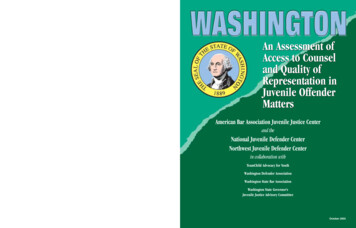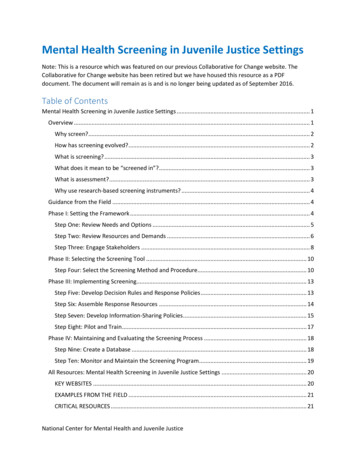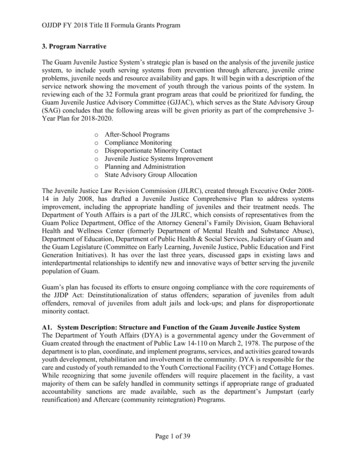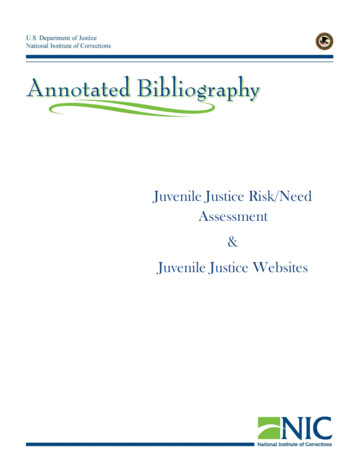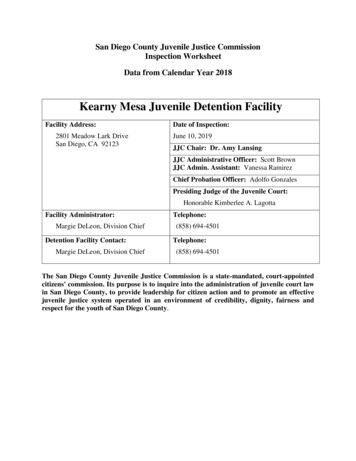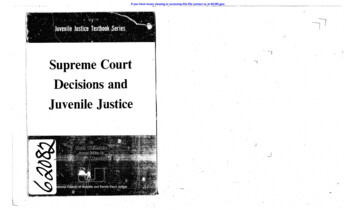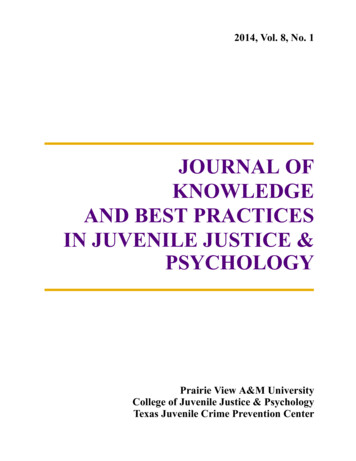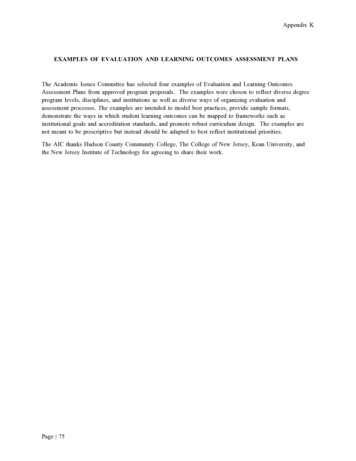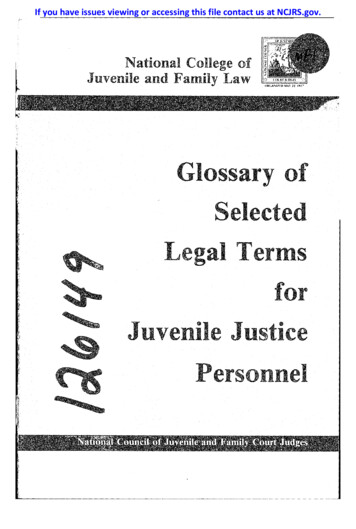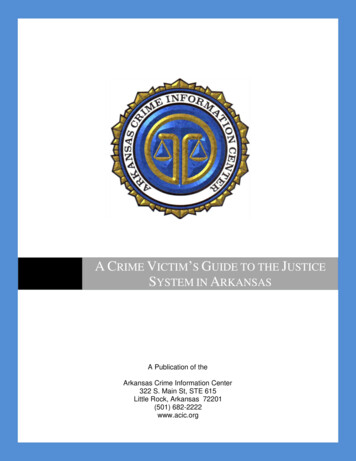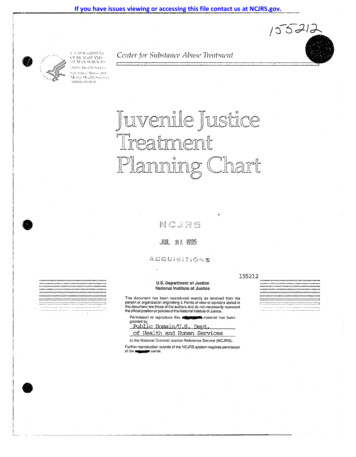
Transcription
If you have issues viewing or accessing this file contact us at NCJRS.gov. --------! t " 1'!·1'.\1'1\1I ';1)llll \) i 11 .\'\ I ,ill \1 \'\ -,I.R\ IlFe,lCClltcr for Suhs/mlce fllnts!' Trmtlllt'lltI u1,11L ik.t1th""t'l\j",,\b'ch\' lInd\ft.I1 ,11 f k,dtlt '-, 'h rll' .1,--,tll" Lm, t'\lhnl1·I'I . tl,itll\nJuvenile JusticeTreaitmelnrlcPlanning ChartU.S. Department of JusticeNational Institute of Justice This document has been reproduced exactly as received from theperson or organization originating it. Points of view or opinions stated inthis document are those of the authors and do not necessarily representthe offiCial position or policies of the National Institute of Justice.Permission to reproduce this.granted bymaterial has beenPublic Cornain/U.S. Dept.of Health and Human Servicesto the National Criminal Justice Reference Service (NCJRS).Further reproduction outside of the NCJRS system requires permissionof the . owner. c: - : : --- ---- -.-, . -- --------,
IntakelArrest*INFORMAL .ADJUSTMENTConditional release\,Release to par ntal custodyShelter care ,.Community diversion*CounselingFILE PETITIONto parental custodyorDetention* pending hearing*Rel aseDrug testing*Positive drug testTreatment* (Tx) referr 1Detoxification*Assessment*TxRelapse prevention*Family counselingCommunity reintegration*Other human services*Infectious diseases risk assessment*POLICE AUTHORITY --------- Drug testingDetoxificationAssessmentTxRelapse preventionFamily counselingOther human servicesInfectious diseases risk a sessment -------------------------------1JUDICIAL ----------------------------------------
-- .-------------- . ---------------------------.- --------- -------- -- ---- -CSAT JUVENILE JUSTICE judication*"' ,// .DismissedorchargeBdroppedII,,.Drug testingDetoxificationAssessmentTxRelapse preventionFamily counselingOther human servicesInfectious diseases risk assessment Key:. Direction of case-person movement: -Unbroken contact'1-l ----'1L-I --'IPlacement under court supervisionArea of continual interagency communication'Area of developmental interagency coordination'oPotential linkages between stepsthat mayor may not occurRelease without supervisionTxTreatment'*Term defined in glossaryTransfer toadult courts
-----------------------------trEATMENT PLANNING CHART.Disposition*COMMUNITY SUPERVISIONProbatiGn*Fine/restitutionCommunity servicesCommunity programsHome detentionCOMMITMENT*: RESIDENTIAL PROGRAMSJuvenile* correctionsDetentionTraining schools and camps*Community residential* facilityRehabilitation programsIntake*Risk/needs assessmentDrug testingReferral for:DetoxificationAssessmentTxRelapse preventionFamily counselingCommunity reintegrationOther human servicesInfectious diseases risk assessmentSuccessfulcompletion ofjustice mandateDrug testingDetoxificationAssessmentTxRelapse preventionFamiiy counselingCommunity reintegrationOther human servicesInfectious diseases risk assessmentiJUVENILE CORRECTIONSIIIa-----1-4
e-!.Aftercare*j,-,;---------------1I, IiIIIIIIIIiCOMMUNITY SUPERVISIONDrug testingDetoxificationAssessmentTxCommunity reintegrationRelapse preventionFamily counselingOther human servicesInfectious diseases risk assessmant 'c,,TMandatory release* (no aftercare)Referral to TxReferral for infectious completion ofjustice mandate)- ---.
Acquittal-Judgment of the court, based on the verdict of ajury or a judicial officer, that the defendant is not guilty ofthe offense(s) for which he or she has been tried.Adjud.icat onhearing-Stage in juvenile court proceedingsin which a judge presides on behalf of the juvenile to determine if he or she actually committed the alleged offense.If the judge rejects the allegations, the juvenile is released.The judge may believe the allegations to be true, but withhold adjudication on condition that the juvenile agree toenroll in a community program that the court feels willhelp resolve the problem.Delinquent youth-Also referred to as a juvenile delinquentor a criminal-type offender, a youth who has been charldwith or adjudicated for conduct that would, under theof the jurisdiction in which the offense was committed, LIa crime if committed by an adult.Detainee-Juvenile held in local, very short-term confinementwhile awaiting consideration for pretrial release, first appearance for arraignment, or disposition.Detention-Temporary care of a juvenile offender or of ajuvenile alleged to be delinquent who requires securecustody in a physically restricting facility pendingdisposition of the case.Afh:t'can:-Control, supervision, and care exercised over juveniles released from facilities through a stated release process.1t may include probation, counseling, enrollment in acommunity program, or any of many forms of treatmentdesigned to lessen the chance that the youth will get introuble again.DeiOJdficati,m-Structured medical or social milieu in whichthe individual is monitored for withdrawal from the acutephysical and psychological effects of drug or alcoholaddiction.t"c;seCi!',mQnQ-Evaluation or appraisal of a candidate's suitability for alcohol or other drug abuse treatment and placement in a specific treatment modality/setting. Thisevaluation includes information regarding current and pastuse/abuse of drugs; justice system involvement; medical,familial, social, educational, military, employment, andtreatment histories; and risk for infectious diseases (e.g.,sexually transmitted diseases, tuberculosis, HIV / AIDS, andhepatitis).Developmentai inh'rage!:ll'), COORdination-Collaborationamong juvenile justice personnel, treatment personnel, andpublic health personnel to form expert justice/ treatment/public health systems. For example, developmental interagency coordination is essential in the assessment of thedrug-involved juvenile offender and in the developmentof referral procedures and reporting policies, as well as inunderstanding each system's definition of success andfailure.CI,)'cAJikawn.t-Process through which the educational, vocational, treatment, and security needs of an offender aredetermined.Di ;,;llic; ",li-Decision by a court to terminate adjUdicatio.all outstanding charges, an action justified whenpre-interview investigation and the facts disclosed 111discussing the case with the juvenile and his or her parentsindicate to the probation officer that the case is unfoundedor when the evidence is untrustworthy or insufficient anddoes not warrant or sustain the charges (also referred to as: I ! - A c t i o n of a judicial officer ordering that ajuvenile subject to judicial proceedings be placed in aparticular kind of confinement or residential facility for aspecified reason authorized by law; also, the result of theaction, that is, the admission to the facility."C!C-Preparation and strategy for each juvenile offender's release from custody. Theplan prepares for the juvenile's return to the community ina law-abiding role after release.' -Program housed in astructure without the security fences and security hardwaretypically associated with correctional facilities, such as aconverted apartment building or private home. Such a program is not constructed as or intended to be a detentionfacility.-Ongoing cooperative effort among treatment personnel, justice personnel,and public health personnel necessary to successfully treatand supervise the drug-involved offender. Communicationamong juvenile justice, treatment, and public health systems facilitates a united approach. Such an approach showsthe juvenile that the systems are omnipresent and omnipotent, which enhances the offender's treatment.-Facility for the incarceration of individuals accused or convicted of criminal activity. A correctional facility must have a separate perimeter that precludesthe regular commingling of the inmates with inmates fromother facilities.llo7le prosequi).- v" .-- J . " " 1 :-Hearing held subsequent to theadjudicatory hearing- in which the judge determines whatorder of disposition should be made concerning a juvenileadjudicated as delinquent. A disposition may be probation,a warning or reprimand, some form of community service,a fine, or "home detention," in which the juvenile continues to live at home but receives rigorous daily counseling.A more stringent disposition may include training schoolor group home placement.-The official halting or suspension, at any legallyprescribed point after a recorded justice system entry, offormal criminal or juvenile justice proceedings against analleged offender. The suspension of proceedings may be inmnjunction with a referral of that person to a treatment orcare program administered by a nonjudicial or a privateagency.t.-Technical examination of urine samples to determine the presence or absence of specified drugs ormetabolized traces.-A nonsecure residential program emphasizing family-style living in a homelike atmosphere. Programgoals are similar to those for large community residentialprograms. Although group homes usually house youths
who are court committed, they also house abused or neglected youths who are placed by social agencies.eearing-A proceeding to determine a course of action, suchas the placement of a ju venile offender, or to determineguilt or innocence in a disciplinary matter. Arguments, witnesses, and evidence are heard by a judicial officer or administrative body in making the determination.Infectious diseases risk assessment-Evaluation of a substance abuser's risk for sexually transmitted diseases, tuberculosis, HIV / AIDS, and other infectious diseases,including information regarding current and past history,screening, and treatment of such diseases. Testing and referral for treatment are recommended for the substanceabuser assessed as at high risk for such diseases. The substance abuser assessed as at low risk should be reassessedintermittently. Thus, collaboration between juvenile justicepersonnel, treatment personnel, and public health personnel must be developed in order to ensure interagency coordina tion in the assessment and trea tmen t of thedrug-involved offender at various stages throughout thejuvenile justice continuum and in the development of referral procedures and reporting policies, as well as in understanding each system's definitions of success andfailure.ftnfl'dim: , di .;t',",t''' "O\"'JriliH\';; c'"Ri.uu: -Administration of screening tests that are sensitive and specific for the detection of tuberculosis, sexually transmitted diseases, HIV /AIDS, and other infectious diseases (e.g., the Mantoux (purified protein derivative) test for tuberculosis, serologiesfor syphilis (noll treponema 1 tests and treponemal confirmatory tests), and Western blot and ELISA for HIV / AIDS).,,\,,;'-Action of taking a juvenile into custody forthe purpose of charging him or her with a crime. The juvenile justice process often begins with an investigation by apolice officer, either because he or she observes a law violation or because a violation is reported. The police officermay release the juvenile to his or her parents with a warning or reprimand or on condition that the juvenile enroll ina community diversion plan or the oi'ficer may take thejuvenile into custody and refer the matter to the juvenilecourt's intake officer for further processing.-Early stage in juvenile court proceedings inwhich a court officer makes a legal judgment of the probable cause of the petition. Generally an intake officer receives, reviews, and processes complaints, recommendsdetention vr release, and provides services for juveniles andtheir families, including diversion and referral to other community agencies.-Person under the age of 21 years, or as defined inthe local jurisdiction as under the age of majority.-Release from an institution required bystatute when an individual has been confined for a period. . . equal to his or her full sentence minus statutory "goodtime," if any.A-Program that provides services tojuveniles who live at home and report to the program on adaily basis. Juveniles in such a program require moreattention than that provided by probation and aftercareservices. Often the program operates its own educationprogram through the local school district.Othf.'R' human services-Supplemental services providedoutside the treatment facility, such as job placement, training, food stamps, and vocational rehabilitation.Petition-Application for court order or other judicial action.In juvenile proceedings, a petition is a document allegingthat a youth is delinquent, a status offendel or a dependent child and asking that the court assume jurisdictionover the juvenile.Probation-Court-ordered disposition alternative not involving confinement through which an adjudicated delinquentis placed under the control, supervision, and care of a probation field staff member.Recidivism-Repetition of criminal behavior.Rdarl'il pr venti()n-Strategy to train alcohol and other drugabusers to cope more effectively and to overcome the stressors/triggers in their environments that may cause relapseinto drug use and dependency.Shdter care-Any nonsecure public or private facility designated to provide either (1) temporary placement for allegedor adjudicated status offenders prior to the issuance of adisposition order or (2) longer term care under a juvenilecourt disposition order.(""','i,,1 iE'ilvestig,1tion-Investigation into the background andcharacter of a delinquent that assists the court in determining the most appropriate disposition.,( ,2 {r"'ii\ t'n-A youth who has been charged with or adjudicated for a status offense, which is conduct declaredby statute to be a crime for children but which would notbe a crime if committed by an adult under the law of thejurisdiction where the offense was committed.',; d': " , ,,,h,"H:;"" ":"iP;,''-, .md ,\l!h'iw,,-Nonsecure residential programs proViding services to youths. Training schoolsare also known as youth development centers, youth villages, youth treatment centers, youth service centers, orschools or homes for boys or girls. Camps and ranches aregenerally located in relatively remote or rural areas. Campshave structured programs that emphasize outdoor work,including conservation and related activities. Typically,ranch residents participate in a structured program of education, recreation, and facility maintenance, including responsibility for the physical plant, its equipment, andlivestock.-Early, thorough, and substantial alcoholand other drug abuse treatment intervention delivered inan unbroken mann r throughout the entire juvenile casehandling process, from intake through the completion ofthe sentence. The components of the system must transfernot only the juvenile but also the cumulative record of whatthe system has learned and what it has done."i,i(
This Juvenile Justice Treatment Planning Chart,developed by the Center for Substance AbuseTreatment (CSAT) presents a simplified model ofthe flow of cases through a typical State juvenilejustice system. Considerations for status offenders,including abused, neglected, runaway, andhomeless youth, are not included in the chart inan effort to simplify this operating model of thejuvenile justice system. The chart illustrates themajor decision points in the juvenile justice systemwhere coordinated strategies for alcohol and otherdrug abuse treatment interventions may beapplied-at intake, social investigation, factfinding hearing, adjudication, disposition, andaftercare.An understanding of the flow of the case-handlingprocess, from intake to release, is essential for coordination and linkage between and among thetreatment and juvenile justice systems. To developcomprehensive alcohol and other drug abusetreatment plans within the juvenile justice system,it is equally critical that the addiction treatme.components be understood.The operation of a State juvenile justice system isa complex process, involving agencies and procedures designed to manage the juvenile offender,to manage the offender's criminal behavior, andto provide for the rehabilitative needs of the juvenile. Most States have developed juvenile justicesystems uniquely responsive to local or regionalinterests and needs. Therefore, some States andlocal jurisdictions may not use all the features suggested in the chart, whereas others may use manymore decision points and options for treating juveniles having addictive disorders. However,CSAT encourages States and local treatment systems to work together with juvenile justice systems, adapting and using the chart as a planningand coordinating tool to develop improvementsin their own substance abuse treatment services .This publication is one of a series of projects developed under contract 270-93-0004 from CSAT.Richard Bast served as the CSAT Government project officer, and Roberta Messalle served as theCSAT coordinator of the Juvenile Justice Treatment Planning Chart project. Duiona Baker, M.P.H.,CSAT, and John Clark, M.D., Chief Medical Officer of the Los Angeles County Jail, were technicaladvisors for infectious diseases and criminal justice, respectively. John 1 . Zachariah, RegionalAdministrator of the American Correctional Association, contributed to the development of thechart and glossary. Project advisors were Robert Anderson, Director, Criminal Justice Projects, National Associationfor State Alcohol and Drug Abuse Directors; Robert Aukerman, Director, Alcohol and Drug AbuseDivision, Colorado Department of Health; Murray Durst, 1.fanager, Substance Abuse Programs,National Council of Juvenile and Family Court Judges; Barbara Zugor, Executive Director, Treatment Alternatives to Street Crime (TASC), Phoenix, AZ; and Timothy Matthews, Director, American Probation and Parole Association.DHHS Publication No. (SMA) 94-2091Substance Abuse and Mental Health Services AdministrationRevised edition, March 1994Available from: National Clearinghouse for Alcohol and Drug Information (NCADI), P.O. Box 2345, Rockville, MD 20852. Telephone: 1-800-729-6686 (in the metropolitan Washington area,301-468-2600). Order No. PHD 598.,.:;
lation or because a violation is reported. The police officer may release the juvenile to his or her parents with a warn ing or reprimand or on condition that the juvenile enroll in a community diversion plan or the oi'ficer may take the juvenile into custody and refer the matter to the juvenile court's intake officer for further processing.
